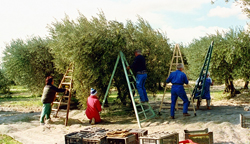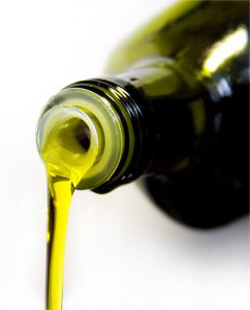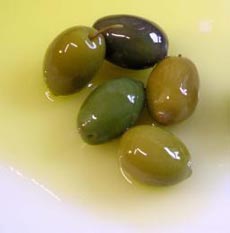Olive Oil & Olives Glossary
Page 3: Terms With D & E
This is Page 3 of the Olive Oil & Olives Glossary. If you think we should consider terms or definitions than those we have provided, use the Contact Us links on this page. Also read our article, Flavors and Aromas of Olive Oil. Visit our collection of 60+ food glossaries to learn more about other food products.
You can click on the letter of the alphabet in the bar below to get to a term
without having to scroll manually.
a b c d e f g h i j k l m n o p q r s t u v w x y z
This glossary is protected by copyright and cannot be reproduced in whole or part.
D.O. or DENOMINATION OF ORIGIN
The Denomination of Origin is a regulated and controlled qualification managed by a Council that is responsible for controlling the characteristics, as well as the authenticity of the products protected by the denomination. It reports to the Ministry of Agriculture. The Denominations of Origin of Spanish olive oil are Baena, Les Garrigues, Priego de Córdoba, Sierra de Segura, Sierra Mágina, Siurana, and Montes de Toledo. Denominations of Quality which have less regulation, include Murcia and Aragón. There are analogous bureaus in Italy, and France to protect their famous agricultural heritage: wines, cheeses, olive oils, and other products. In France the designation is A.O.C. or Appellation d’Origine Controlée. Italians use D.O.P., which stands for Denominazione d’Origine Protetta (some other countries in the European Union also use D.O.P. now, including Portugal).
D.O.P. or DENOMINAZIONE d’ORIGINE PROTETTA
Denominazione d’Origine Protetta (some other countries in the European Union also use D.O.P. now, including Portugal), the Italian certification of authenticity of origin. See also D.O. and A.O.C.
DRIED OLIVES or DRIED GREEK OLIVES
Black olives are dried and cured in olive oil and salt—known as Greek-style dried olives. The process intensifies the flavor and produces a saltier olive, excellent for cooking—in stews; with roast veal, lamb and pork; in tomato sauces; in salads; and with a glass of robust red wine,.
EARLY HARVEST OLIVE OIL -or- FALL HARVEST OLIVE OIL
IOOC Definition: Olives reach their full size in the fall but may not fully ripen from green to black until late winter. Green olives have slightly less oil, more bitterness and  can be higher in polyphenols. The oil tends to be more expensive because it takes more olives to make a bottle of oil. Many people like the peppery and bitter quality of early harvest oil. Flavor notes of grass, green, green leaf, pungent, astringent are used to describe early harvest fall oils. Because of the higher polyphenols and antioxidants, early harvest oils often have a longer shelf life and are blended with late harvest oils to improve their shelf life. See also late harvest olive oil. can be higher in polyphenols. The oil tends to be more expensive because it takes more olives to make a bottle of oil. Many people like the peppery and bitter quality of early harvest oil. Flavor notes of grass, green, green leaf, pungent, astringent are used to describe early harvest fall oils. Because of the higher polyphenols and antioxidants, early harvest oils often have a longer shelf life and are blended with late harvest oils to improve their shelf life. See also late harvest olive oil.
Photo: Harvesting olives in Provence at CastelaS.
EMPELTRE OLIVE
A medium-size, black olive grown in Spain that produces a high-quality olive oil. It is also enjoyed as a table olive.
ESTATE OIL -or- SINGLE ESTATE OIL
Top quality oil from olives grown on a single individual estate or farm. The olives are  usually harvested by hand and the oil is pressed and bottled on site. Estate production is generally characterized by small production, more ideal growing, harvesting and production conditions. While not better in terms of healthful qualities, estate oils do offer consumers a wider choice of complex flavors and aromas. Estate oils are among the best that are available and they are expensive. They are usually sold on site or in specialty shops and are often displayed away from bright light, which caused deterioration in the flavor and quality of the oil. (In food stores, displays of olive oil may be exposed to heat and light, but because of the quick turnover in most stores, this may not result in a significant problem with the quality. Because premium-priced oils move less quickly, it is an in issue with the most expensive oils.) usually harvested by hand and the oil is pressed and bottled on site. Estate production is generally characterized by small production, more ideal growing, harvesting and production conditions. While not better in terms of healthful qualities, estate oils do offer consumers a wider choice of complex flavors and aromas. Estate oils are among the best that are available and they are expensive. They are usually sold on site or in specialty shops and are often displayed away from bright light, which caused deterioration in the flavor and quality of the oil. (In food stores, displays of olive oil may be exposed to heat and light, but because of the quick turnover in most stores, this may not result in a significant problem with the quality. Because premium-priced oils move less quickly, it is an in issue with the most expensive oils.)
Photo by Pawel Kryj | SXC.
EXTRA LIGHT OLIVE OIL
The lowest quality olive oil generally available at retail, this oil is heavily processed. The next best grade is pure olive oil (or simply, “olive oil”), which is minimally processed; then virgin and extra virgin olive oil.
EXTRA VIRGIN OLIVE OIL (EVOO)
For a complete definition, see virgin olive oil. EVOO is the most expensive and highest in quality, with excellent flavor and aroma, and is best used as a condiment for dressing foods and salads or as a dipping oil. Although it can be used for baking, it is best not to heat this fine oil, as its high quality flavors will dissipate.
Continue To Next Page: Terms With F & G
Go To The Article Index Above
Lifestyle Direct, Inc. All rights reserved. Images are the copyright of their individual owners.

|





 can be higher in polyphenols. The oil tends to be more expensive because it takes more olives to make a bottle of oil. Many people like the peppery and bitter quality of early harvest oil. Flavor notes of grass, green, green leaf, pungent, astringent are used to describe early harvest fall oils. Because of the higher polyphenols and antioxidants, early harvest oils often have a longer shelf life and are blended with late harvest oils to improve their shelf life. See also
can be higher in polyphenols. The oil tends to be more expensive because it takes more olives to make a bottle of oil. Many people like the peppery and bitter quality of early harvest oil. Flavor notes of grass, green, green leaf, pungent, astringent are used to describe early harvest fall oils. Because of the higher polyphenols and antioxidants, early harvest oils often have a longer shelf life and are blended with late harvest oils to improve their shelf life. See also  usually harvested by hand and the oil is pressed and bottled on site. Estate production is generally characterized by small production, more ideal growing, harvesting and production conditions. While not better in terms of healthful qualities, estate oils do offer consumers a wider choice of complex flavors and aromas. Estate oils are among the best that are available and they are expensive. They are usually sold on site or in specialty shops and are often displayed away from bright light, which caused deterioration in the flavor and quality of the oil. (In food stores, displays of olive oil may be exposed to heat and light, but because of the quick turnover in most stores, this may not result in a significant problem with the quality. Because premium-priced oils move less quickly, it is an in issue with the most expensive oils.)
usually harvested by hand and the oil is pressed and bottled on site. Estate production is generally characterized by small production, more ideal growing, harvesting and production conditions. While not better in terms of healthful qualities, estate oils do offer consumers a wider choice of complex flavors and aromas. Estate oils are among the best that are available and they are expensive. They are usually sold on site or in specialty shops and are often displayed away from bright light, which caused deterioration in the flavor and quality of the oil. (In food stores, displays of olive oil may be exposed to heat and light, but because of the quick turnover in most stores, this may not result in a significant problem with the quality. Because premium-priced oils move less quickly, it is an in issue with the most expensive oils.)